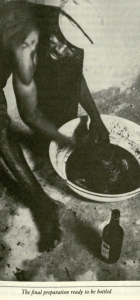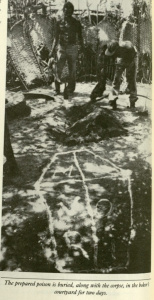How does a victim turn into a zombie? Who carries out the ritual and how is vodou involved in zombification? What happens after one becomes a zombie both physically and psychologically?

One of the most fascinating and intricate processes in Haitian Vodou is zombification, which revives the recently dead into mindless, soulless zombies. As part of the vodou religion, the bokors (Haitian vodou sorcerers) have the power to create and control zombies. The exact methods and concoctions used vary among bokors, but the process believed by the Haitain people describes the following general pattern. Some zombification processes use blood and hair from their victims in addition to using vodou dolls, while others involve a carefully prepared mixture called “coup de poudre” (“powder strike”) made of mystical herbs, human remains, and animal parts. Administrating this mixture can also vary from ingestion, injection, or even a blow dart (“The Bokor and Magic Powder”).

Right – Bokor preparing the poison: the mortar and pestle


Once the mixture has been made by the bokor and administered to the victim, it starts to take effect on the body. The victim becomes immobile, has an incredibly faint heartbeat, and his or her breathing is drastically reduced within a few minutes so that the victim appears dead. While in this death-resembling state, the victim is still fully aware of the surroundings but cannot express himself. Once taken to the hospital and declared dead by the doctor, the seemingly lifeless body is buried in a grave soon after death (since the heat and lack of refrigeration generally in Haiti makes the bodies decay rapidly).


After the body is buried, the bokor enters the grave and digs up the body. This happens within eight hours of the burial because otherwise the victim will die of asphyxiation. Next, the bokor performs an ancient vodou rite where he or she captures the victim’s ti bon ange, which is the part of the soul directly connected to an individual. He or she can do this by capturing it within seven days immediately following the death of the corps cadavre, while it is still hovering over the corpse, or by spreading poisons in the form of a cross on the threshold of the victim’s doorway. Either way, this effects a split in the spiritual parts of the victim and produces two complementary types of zombies: the spirit zombi (the zombie of the ti bon ange alone) and the zombi cadavre (the zombi of the flesh, which is composed of the n’ame, the gros bon ange, and the z’etoile) (“The Ethnobiology of the Haitian Zombi” 99). Then he traps the spirit zombi part of the soul (or zombi astral) in a small clay jar or some other commonplace container, and replaces it with the loa that the bokor controls. This container is hidden in a secret place known only to the bokor and is finally wrapped in a piece of the victim’s clothing or some other personal possession.
After a day or two, the bokor then administers a hallucinogenic mixture called the “zombi’s cucumber” that revives the victim and is used to keep the zombie in a state of submissive confusion (“The Bokor and Magic Powder”). In this state, the zombi cannot speak, has no memory, and no longer resembles its past human personality. As a result, the zombi is easy to control and the bokor can use the zombi as a slave for farm labor and construction work. The zombies are completely under the rule of the bokor that made them and consequently work as slaves until the bokor dies. Once they are released from their slave labor, the zombies can finally return to their home village or place of burial and die.
A major concern in Haitian folklore concerning zombies is the act of feeding salt to a zombie. While zombies are usually not particularly dangerous, giving them salt will return their senses and restore their personality. This will lead the zombies to attack the bokor who created them or to return to their place of burial for their final death.
While zombification seems at first to be a strictly physical experience, there is additionally a psychological aspect in the ritual and is a spiritual process. A psychological or cultural predisposition is imperative in order for the victims to become a zombi. After being buried alive, the victim’s reawakening as a zombi follows a psychotic state. The victim is able to reconstruct their identity as a zombi due to a combination of the psychosis induced by the drugs, the psychological trauma of being buried alive, and the strong beliefs of zombies in their culture. This all contributes to the psychological aspect that controls the victim’s perception and actions. Living in Haiti and the social reinforcement of their beliefs in zombies further contribute to their zombie identity and experience. Scottish psychiatrist R. D. Laing emphasized the connection between social and cultural expectations and compulsion, in the context of schizophrenia and other mental illness (“Haitian Vodun or Voodoo Zombie”). He observed that schizogenesis may contribute to the psychological aspects of zombification.
The following six part video titled “Investigating the Haitian Zombie” is Hamilton Morris’s quest in Haiti to discover the secrets of zombification and the poison’s formula to do a formal chemical analysis. Hamilton Morris is a journalist and science editor for Vice magazine where he travels around the world to investigate unusual psychoactive drugs. Check out these interesting videos for a visual of his adventures while trying to understand the process of zombification in Haiti:
Investigating the Haitian Zombie (Part 1/6)
Investigating the Haitian Zombie (Part 2/6)
Investigating the Haitian Zombie (Part 3/6)
Investigating the Haitian Zombie (Part 4/6)
Excellent article merci
You’ve got astonishing stuff at this point
Heya i am for the first time here. I came across this board and I find
It truly useful & it helped me out much. I hope to give something back and aid others like you helped me.
Sustain the amazing work !! Lovin’ it!
Have you ever considered creating an ebook or guest authoring on other sites?
I have a blog based upon on the same subjects you discuss and would really
like to have you share some stories/information. I know my audience would
appreciate your work. If you are even remotely interested, feel free to shoot me an e mail.
I love reading about zombie’s too
truly useful & it helped me out a lot.
Awesome Blogpost thank you for sharing.
Many thanks for the careful and significant information. A very valued and well-founded publishing!
I really liked the article I will share with my friends
I’m impressed, I have to admit. Seldom do I encounter a blog that’s both educative and amusing, and without a doubt, you’ve hit the nail on the head. The issue is an issue that too few folks are speaking intelligently about. Now i’m very happy I stumbled across this in my search for something regarding this.
I loved this it helped me out alot thank you so much.
Hello, how are you? I really liked the article on your website I will even share it with my group
Hello, a really great article, congratulations
Thanks
Thanks for sharing this article. This article includes very good information that I wasn’t aware of it. I really enjoyed reading it. Keep sharing.
Thanks for sharing this important information. I really enjoyed reading it. Keep sharing.
truly useful & it helped me out a lot.
Extremely informative and easy to understand. Thank you!
Thank you for sharing this informative article. Ideally enjoyed reading this article.
For some, this article might be scary with all voodoo things, but such topics are really intriguing.
I really liked the article. It helped me out alot thank you so much.
Extremely informative and easy to understand. It helped me out alot thank you so much.
It’s an eye-opening process of zombification.
Wade Davis is the most well-known researcher to explore the Haitian zombi. He sets out to prove the scientific reality of zombi production, claiming to have found a zombi-creating medicine and its antidote.
AMAZING INFORMATION , I appreciate
Really Great post, Congratulations!
Frightening but interesting
Nice!
Strange but curiously interesting. This should be documented more
Never seen or read anything like this in a long while. This is good work
Thankyou for the information it is helpful.
Thank you for sharing your passion and knowledge with the world.
Your blog has broadened my horizons and enriched my understanding of the world.
Beautiful Article, Thanks for sharing
I really liked the article. It helped me out about Zombification
Your article on the zombification process in Haitian Vodou is indeed a captivating exploration of a fascinating and mystifying topic. It delves into the intricate details of this ritualistic practice, providing readers with valuable insights into its history, methods, and psychological aspects.
Your article opens with a captivating introduction, immediately piquing the reader’s interest by raising questions about the process of creating zombies. It successfully sets the tone for a compelling journey into the realm of Haitian Vodou.
The information you provide regarding the role of bokors (Haitian Vodou sorcerers) and the methods employed in zombification is not only enlightening but also thought-provoking. The description of the concoctions used, such as “coup de poudre,” is intriguing. Moreover, the inclusion of visual elements, like photographs, adds an extra layer of authenticity to your content, enhancing the reader’s comprehension.
The step-by-step description of the zombification process, from the administration of the mixture to the victim’s burial, exudes a sense of mystery and leaves the reader eager to learn more. Your explanation of the split in the spiritual parts of the victim, resulting in two types of zombies, is particularly illuminating.
The psychological dimension you introduce is a critical aspect of the article. It’s commendable how you address the victim’s psychological state, the influence of drug-induced psychosis, and the role of cultural beliefs in shaping the perception of zombification. This adds depth and complexity to the narrative, making it not only informative but also engaging.
Lastly, your inclusion of the video series, “Investigating the Haitian Zombie,” serves as a valuable supplement to your written content. It allows readers to visualize and experience the journey you describe, making the subject matter even more captivating.
In conclusion, your article is a well-researched and thoughtfully presented exploration of the zombification process in Haitian Vodou. It combines historical context, intricate rituals, and psychological aspects to provide readers with a comprehensive understanding of this captivating topic. Your article is not only informative but also highly engaging.
Thank you for sharing this intriguing piece of cultural exploration with your readers.
Sincerely,
Outstanding piece of writing
I love this article. I am definitely sharing it with my connections of LinkedIn.